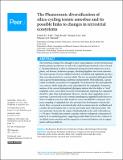The Phanerozoic diversification of silica-cycling testate amoebae and its possible links to changes in terrestrial ecosystems
Author(s)
Lahr, Daniel J.G.; Bosak, Tanja; Lara, Enrique; Mitchell, Edward A.D.
DownloadBosak_The Phanerozoic.pdf (15.24Mb)
PUBLISHER_CC
Publisher with Creative Commons License
Creative Commons Attribution
Terms of use
Metadata
Show full item recordAbstract
The terrestrial cycling of Si is thought to have a large influence on the terrestrial and marine primary production, as well as the coupled biogeochemical cycles of Si and C. Biomineralization of silica is widespread among terrestrial eukaryotes such as plants, soil diatoms, freshwater sponges, silicifying flagellates and testate amoebae. Two major groups of testate (shelled) amoebae, arcellinids and euglyphids, produce their own silica particles to construct shells. The two are unrelated phylogenetically and acquired biomineralizing capabilities independently. Hyalosphenids, a group within arcellinids, are predators of euglyphids. We demonstrate that hyalosphenids can construct shells using silica scales mineralized by the euglyphids. Parsimony analyses of the current hyalosphenid phylogeny indicate that the ability to “steal” euglyphid scales is most likely ancestral in hyalosphenids, implying that euglyphids should be older than hyalosphenids. However, exactly when euglyphids arose is uncertain. Current fossil record contains unambiguous euglyphid fossils that are as old as 50 million years, but older fossils are scarce and difficult to interpret. Poor taxon sampling of euglyphids has also prevented the development of molecular clocks. Here, we present a novel molecular clock reconstruction for arcellinids and consider the uncertainties due to various previously used calibration points. The new molecular clock puts the origin of hyalosphenids in the early Carboniferous (∼370 mya). Notably, this estimate coincides with the widespread colonization of land by Si-accumulating plants, suggesting possible links between the evolution of Arcellinid testate amoebae and the expansion of terrestrial habitats rich in organic matter and bioavailable Si.
Date issued
2015-09Department
Massachusetts Institute of Technology. Department of Earth, Atmospheric, and Planetary SciencesJournal
PeerJ
Publisher
PeerJ Inc.
Citation
Lahr, Daniel J.G. et al. “The Phanerozoic Diversification of Silica-Cycling Testate Amoebae and Its Possible Links to Changes in Terrestrial Ecosystems.” PeerJ 3 (2015): e1234.
Version: Final published version
ISSN
2167-8359